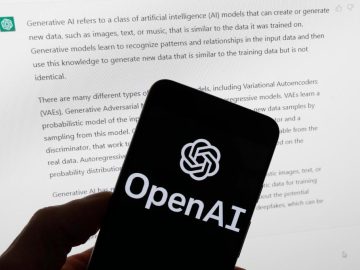Any new technology advancement comes with benefits as well as challenges attached. Financial industry always maintains a follower strategy, accepting a NextGen solution. However, there are some non-impacting financial use cases which can influence customers
in terms of behavior and sentiments through the current NextGen technology (Gen AI).
In this article I have tried to represent various use cases, where Gen AI can play a vital role to transform Banks, as well as the unanticipated benefits and challenges.
Let us start with basics…
What is AI?
Artificial intelligence (AI), is an intelligence exhibited by computer systems.
It is a field of research in computer science that develops and studies methods and software that enable machines to perceive and use learnings and intelligence to take actions; that maximizes their chances of achieving a defined goal. Such machines may
be called AIs.
What is Generative AI?
Generative artificial intelligence (generative AI, GenAI, or GAI) is artificial intelligence capable of generating text, images, videos, or other data using generative models, often in response to prompts. Generative AI models learn the patterns and structure
of their input, train data and then generate new data set that has similar characteristics.
Finance industry and GenAI
Financial industry segment is the backbone of any country, organization, or an individual. This industry follows a strict rules and regulations governed by the regulatory organization. The financial sector faces multiple challenges in today’s digitalized
life. Leveraging the NextGen technology financial industry is trying to overcome from these challenges as well as trying to provide an upgraded up hilled customer experience.
Generative AI is one such NextGen technology, which can create a foundation for digital transformation in financial sector. Generative AI (GenAI) is quickly evolving, and it is going to take a major jump forward. GenAI has shown the capabilities cross text,
audio, images, and video over the past couple of years, and the next stage of GenAI is likely to be even more transformative. Generative AI has the potential to revolutionize the banking and payment industry in several significant ways. Generative AI offers
numerous use cases in the financial industry, transforming various aspects of operations, customer service, risk management, and product innovation. Here are some key areas and use cases:
1. Fraud Detection and Prevention
Generative AI can enhance fraud detection by scanning, learning to recognize patterns and anomalies that traditional systems might miss. By analyzing vast amounts of transaction data in real-time, AI models can identify suspicious activities and flag them
for further investigation, reducing the false positive incidence of fraud and improving security.
- Anomaly Detection: Generative AI models can learn the normal patterns of transactions and detect anomalies that might indicate fraudulent activities
- Synthetic Data Generation: Creating synthetic data to train fraud detection models without compromising real customer data.
2. Personalized Financial Services Assistance
Generative AI can help banks offer personalized financial advice and services to their customers. By analyzing individual spending patterns, financial goals, and preferences, AI can create customized financial plans, investment strategies, and even predict
future financial needs.
- Customized Financial Advice: Generative AI can analyze customer data to provide personalized financial advice and investment recommendations.
- Dynamic Product Offerings: Tailoring financial products and services to individual customer needs based on predictive analytics.
3. Enhanced Customer Experience
AI-powered chatbots and virtual assistants can provide 24/7 customer support, handle inquiries, and perform transactions. This improves customer satisfaction by offering quick and efficient service without the need for human intervention.
- AI-Powered Chatbots: Virtual assistants can handle customer inquiries, perform transactions, and provide support 24/7.
- Enhanced Interaction: Generative AI can improve the quality of interactions by understanding and predicting customer needs more accurately.
4. Automated Risk Management
Generative AI can assess and manage risk more effectively by analyzing large datasets and predicting potential risks. This helps banks in making informed decisions about lending, investments, and other financial activities, thereby minimizing losses.
- Credit Scoring: Generative AI can create more accurate and dynamic credit scoring models by analyzing large amounts of data from multiple sources.
- Predictive Risk Analysis: Identifying potential risks in investments, loans, and other financial activities before they materialize.
5. Streamlined Operations
AI can automate various back-office operations, such as document processing, compliance checks, and transaction monitoring. This not only reduces operational costs but also improves accuracy and efficiency.
- Process Automation: Automating routine tasks such as document processing, transaction verification, and customer onboarding.
- Resource Allocation: Optimizing the allocation of resources within the organization based on predictive analytics.
6. Predictive Analytics for Decision Making
Generative AI can analyze historical data to provide predictive insights, helping banks make better decisions regarding market trends, customer behavior, and business strategies. This can lead to more informed decision-making and improved business outcomes.
- Market Trend Analysis: Generative AI can analyze historical data and current market conditions to predict future trends and assist in strategic planning.
- Cash Flow Forecasting: Providing accurate predictions of cash flow to help businesses manage their finances better.
7. New Financial Products Innovation
Generative AI can assist in the creation of innovative financial products tailored to the specific needs of different customer segments. By leveraging AI’s ability to analyze market trends and customer data, banks can develop products that are more aligned
with customer demands.
- New Financial Products: AI can identify gaps in the market and assist in designing new financial products that meet emerging customer needs.
- Dynamic Pricing Models: Creating pricing models that adjust in real-time based on market conditions and customer needs.
8. Improved Compliance and Regulatory Adherence
AI can help banks stay compliant with regulatory requirements by continuously monitoring transactions and operations for compliance. It can also assist in generating reports and ensuring that all activities meet the required standards.
- Automated Reporting: Generative AI can automate the creation of regulatory reports, ensuring accuracy and timeliness.
- Compliance Monitoring: Continuous monitoring of transactions and operations to ensure compliance with regulatory standards.
9. Enhanced Data Analysis
Enhanced data analysis is one of the most promising applications of generative AI in the financial industry.
- Text and Sentiment Analysis: Analyzing unstructured data such as news articles, social media posts, and financial reports to gain insights into market sentiment and trends.
- Natural Language Processing: Improving the understanding and processing of complex financial documents and reports.
10. Customer Risk Profiling
Generative AI can significantly enhance the accuracy and effectiveness of customer risk profiling by leveraging advanced data analysis and predictive modelling techniques.
- Behavioral Analysis: Understanding customer behavior and risk profiles to tailor products and mitigate potential risks.
- Loan Default Prediction: Predicting the likelihood of loan defaults and taking proactive measures to mitigate risks.
Benefits of Generative AI
- Improved Accuracy and Insights: Generative AI models can uncover complex patterns and relationships in data that traditional methods might miss, leading to more accurate predictions and deeper insights.
- Increased Efficiency: Automation of data analysis processes reduces the time and effort required for manual analysis, allowing financial professionals to focus on strategic decision-making.
- Better Decision-Making: Enhanced data analysis provides financial institutions with actionable insights, enabling better decision-making in areas such as investment strategies, risk management, and customer engagement.
- Innovation and Competitive Advantage: By leveraging generative AI, financial institutions can develop innovative products and services, gaining a competitive edge in the market.
- Enhanced Customer Experience: Improved data analysis enables financial institutions to understand customer needs better and offer personalized services, enhancing customer satisfaction and loyalty.
Challenges and Considerations
While the potential benefits are substantial, there are challenges that need to be addressed:
- Data Privacy and Security: Ensuring that customer data is protected and used ethically.
- Bias and Fairness: Avoiding biases in AI algorithms that could lead to unfair treatment of customers.
- Integration with Existing Systems: Seamlessly integrating AI with current banking infrastructure.
- Regulatory Compliance: Adhering to regulatory standards while implementing AI solutions.
Conclusion
The integration of generative AI in the financial industry promises to bring about significant improvements in efficiency, customer service, and innovation. However, it is crucial for financial institutions to carefully manage the challenges to fully realize
the potential of AI technologies.
Generative AI is set to transform the financial industry by enhancing efficiency, improving customer service, and enabling innovation. Financial institutions that successfully navigate the challenges and leverage AI’s capabilities will gain a significant
competitive advantage.




